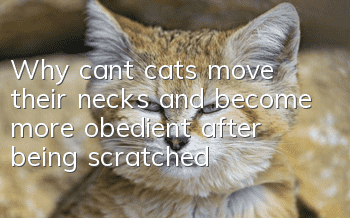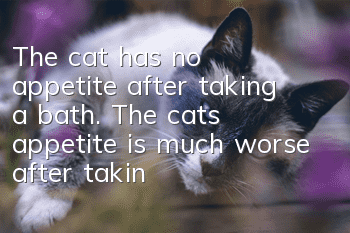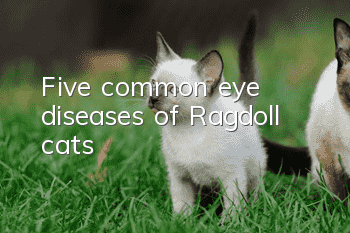Why can’t cats move their necks and become more obedient after being scratched?

If you are a parent of a cat, have you ever had this experience in your life? The cat is mischievous and you try your best to catch it and teach it a lesson but you are unable to do anything. In the end, both you and the cat collapse from exhaustion. On the side, you stretched out your hand abruptly and grabbed the back of the cat's neck. The cat suddenly stopped struggling and remained motionless.
A cat will not move after being grabbed by the back of the neck. However, are all cats like this? Let’s first take a look at folded-eared cats.
Mr. Yin is the owner of a fold-eared cat. He has been raising this folded-eared cat at home for a year and a half. Although he is relatively well-behaved on weekdays, he still accidentally scratches his owner. Mr. Yin said that as long as the cat's alert parts are avoided, it will not hurt anyone, but it does not stop it from moving! So, can scratching the back of the neck make it stay still like in the video?
As a result, after Mr. Yin caught the kitten, the folded-eared cat really seemed to have been stabbed, with its limbs spread out and motionless. Could it be that the kitten recognizes its owner? Next, the reporter tested it himself. When the reporter experienced it this time, he found that the kitten was stunned for three or four seconds when it was picked up by the flesh on the back of its neck. But it soon became active again. Mr. Yin told reporters that maybe the reporter's technique of catching him was a bit harsh and the kitten was unwilling.
Through personal experience with the first kitten, we found that the method of grabbing the skin on the back of the kitten's neck is really effective, but the duration is a bit short.
Let’s take another look at a Norwegian forest cat. Its size is much larger than Zhe Er.
As a result, this 12-year-old cat had the same situation. After being picked up by the skin behind its neck, its limbs spread out and became motionless.
Next is the third experimental kitten. This is an adult Siamese cat. When the meat on the back of the neck is also grabbed, the Siamese cat should move and how to move. So why do some kittens really stop moving when using the same method, while others have no effect at all?
In fact, different cats have individual differences. Generally speaking, most cats will become quieter or even completely motionless when the skin on the back of their neck is grabbed.
Because the big cat holds the kitten directly by its neck when raising it, it thinks that the mother is holding it, and if it is moved around, it will fall and fall, so it will not move. But after a long time, it didn't want to. Because the cat is uncomfortable in just one position.
In other words, it is actually a genetic reaction for a cat to become quiet after being grabbed by the skin on the back of its neck. However, because the feeling of a human hand is different from the feeling of a mother cat picking up a child, the cat will recover within a certain period of time. As is. As for the kitten that moved around like the third experimental cat from the moment it was caught, it is likely to be related to its individual previous experience.
A group of Japanese neurobiologists studied a series of physiological responses when "animals are picked up by their mothers" and found that similar "sedative effects" exist not only in mice, but also in human infants. The three most typical physiological responses to the "sedation effect" that are similar between humans and mice are: cessation of crying, compliance, and slowing of the heartbeat.
This research is of great significance, because the "consistency of physiological responses between species" allows scientists to use mice (rather than human infants) to study the reasons behind the phenomenon, and the research results not only explain the "what this article is trying to answer" "A clamp freezes a cat" question also answers another question that is more relevant to us humans: "Why picking up and rocking a baby when it cries can calm the baby."
In the experiment, they anesthetized the nerves that sense movement in the necks of young mice. After that, the "sedative effect" caused by being "picked up" weakened. Also, surgical removal of part of the brain to disrupt incoming signals from the cerebellar cortex also lengthened the time it took for the mother to calm her pups. If the baby rat cannot sense being grabbed at the back of its neck, the baby rat will not curl up; if the cerebellum cannot receive the signal, the baby mouse will not be obedient. The weakening of the heartbeat and changes in body posture are directly realized by the parasympathetic nerves and the efferent nerves of the cerebellum. This series of physiological reactions makes the pups quiet, obedient, and curl up so that the mother can take them to a safe place.
Therefore, it is not that the meat on the back of the cat’s neck is dead. On the contrary, it is the receptor nerves on the back of the neck that allow the kitten to get the signal “I am being picked up”; and the subsequent physiological reaction similar to that of being tapped is not Because "the nerve channels are blocked", but because the signals from the brain guide them to have physiological phenomena that facilitate numbness and transfer themselves.
- How to tame a naughty cat? A smart scavenger will do this!
- What's wrong with the cat's buttocks?
- Why do Occi cats need to be neutered?
- Advantages and Disadvantages of Having Cats at Home
- Can kittens eat chocolate?
- How to judge the quality of cat litter? (Four criteria for judging the quality of cat litter)
- Which deworming medicine is best for cats? Choose the right medicine to get twice the result with half the effort
- Tips and precautions for raising cats and dogs in winter
- Raising a cat is a comfortable thing, but do you dare to raise a cat? These 6 points are "scary"
- What are the causes of constipation in cats?



